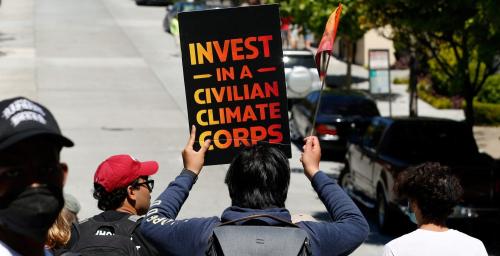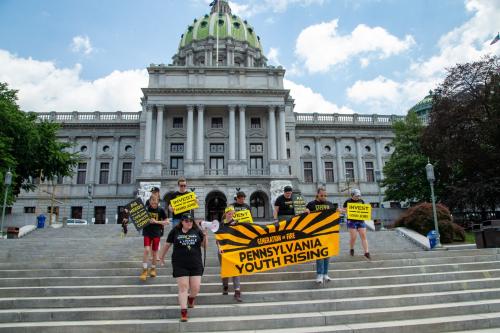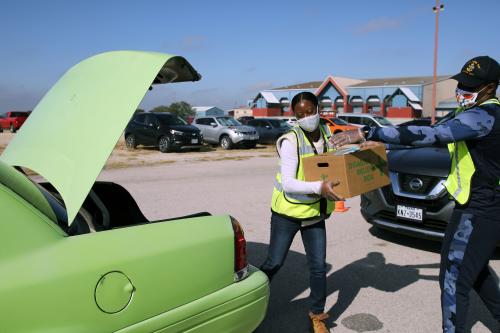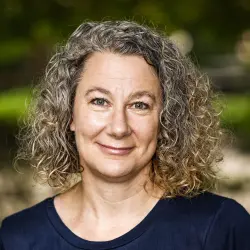The pathway from adolescence to adulthood and a good job in the United States should not be an obstacle course. But it is—and it will remain that way unless we create more and better options to prepare young people for employment and life.
At the same time, America’s youth also face a future of costly, deadly disasters due to climate change. The economic and climate challenges young adults face may not seem related, but one program could address both: the Civilian Climate Corps, which would put young people to work addressing a range of environmental problems while also offering structure and a paycheck.
Unfortunately, the Build Back Better legislation that would support the Corps is stalled in the U.S. Senate, despite more evidence every day that we must reverse the trends damaging young people’s chance at a better future. As President Joe Biden and his congressional allies consider their options, it is imperative that the Civilian Climate Corps be included in any future legislative agenda.
Millions of young people don’t get a shot at economic success
In a forthcoming analysis on the employment trajectories of young adults, Child Trends and Brookings Metro will show just how difficult it is to move up the economic ladder. We identified adults who had experienced at least one type of disadvantage in their teens (such as growing up in a low-income family) and followed them through their twenties and into their early thirties.
Based on their employment histories, we segmented these adults into four distinct groups. One group, accounting for 10% of the adults we followed, were clear economic winners, with average annual earnings of about $68,000 at age 25 and nearly $100,000 at age 30. The second group, comprising one-third of the adults we followed, landed on fairly secure economic ground, with average earnings of $35,000 at age 25 and $42,000 at age 30.
However, the rest of those we followed—more than half—did not fare so well. More than one-third of the adults in our analysis fell into the ranks of the working poor, with average annual earnings of about $18,000 at age 25 and $19,000 at age 30. They predominantly work in low-wage occupations such as retail clerks, nurse aides, home care workers, janitors, and cooks. Another 20% work only sporadically and have higher poverty rates at age 30 (54%) than age 18 (50%). The lower-earning groups are disproportionately female, Black, and Latino or Hispanic, while the highest earning group is disproportionately white and male.
Consider what it is like to live on $19,000 per year. That translates into about $1,600 per month before taxes. That is not much to live on, much less invest in the future, save for a rainy day, or pay for unexpected expenses such as car repairs or medical bills.
This is what happens when educational systems, labor market institutions, and social policy fail to provide the necessary conditions for all young people to thrive as they move into adulthood: millions are consigned to the economic and social margins.
And these findings reflect pre-COVID-19 data. Today, things are even more confusing and chaotic for young people. At the end of 2021, the unemployment rate among 20- to 24-year-olds was double that of 25- to 54-year-olds (7.1% and 3.5%, respectively). Remote learning has led to serious learning loss among K-12 students, and college enrollment is down sharply, especially at community colleges. Teachers note they have not been able to provide the same level of college and career readiness counseling as before the pandemic, and many recent high school graduates report overwhelming levels of uncertainty, anxiety, and confusion about their future.
A Civilian Climate Corps can give America’s young people a broader set of choices
To upend these patterns of who has a shot at success and who doesn’t, we need to develop a broader set of choices for adolescents and young adults. These choices need to: 1) prepare young people for good jobs through education, training, and paid work experience; 2) help young people develop supportive relationships with adults; and 3) provide supports to help young people stay on track. Moreover, these opportunities need to be intentionally targeted to young people who are most likely to fall through the cracks.
This is entirely possible. The Build Back Better bill passed by the U.S. House of Representatives last fall earmarked billions of dollars for federal agencies to work together to mitigate the impacts of climate change via the Civilian Climate Corps (CCC). As part of the CCC, young people would work on a range of projects, earn a decent wage, and get valuable opportunities to build their skills and networks. Corps members could work in urban, rural, and suburban settings on projects such as trail maintenance, forest management, home weatherizing, electronic waste recycling, green infrastructure to reduce stormwater runoff and flooding, and more.
The CCC does not need to start from scratch. There is a robust network of state and local conservation corps as well as aligned programs such as AmeriCorps and YouthBuild that combine paid, community-oriented work with mentoring, skills training, and scholarships. Federal, state, and local governments already have experience supporting and partnering with these organizations.
Moreover, the newly passed Infrastructure Investment and Jobs Act authorizes billions of dollars for projects to transportation, water, energy, and environmental resilience and rehabilitation. In turn, this will create demand for workers in an array of occupations in engineering, maintenance, construction, and more. The CCC would be a natural pipeline to these positions.
Unfortunately, the CCC’s prospects are uncertain, as the Build Back Better legislation is stalled in the U.S. Senate and unlikely to move forward in its current form. Congress may move ahead with specific provisions in separate legislation, but that remains to be seen.
The need for a Civilian Climate Corps at this crucial moment could not be clearer. Science shows that we need to take action now to address climate change. Meanwhile, for decades, the United States has profoundly failed to provide sufficient guidance and support to millions of young people transitioning to adulthood, leaving them with two bad choices: an expensive, confusing postsecondary landscape or a labor market largely offering low-wage jobs.
It is not often that one policy offers a chance to address two separate, urgent priorities—but the Civilian Climate Corps does. We can address the climate crisis and support our young people at the same time. The United States Congress should do its job and pass legislation that meets the moment.
The Brookings Institution is committed to quality, independence, and impact.
We are supported by a diverse array of funders. In line with our values and policies, each Brookings publication represents the sole views of its author(s).







Commentary
America’s young people face a grim future. A Civilian Climate Corps can help.
January 27, 2022